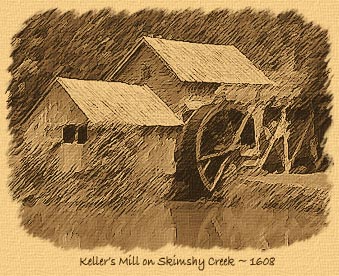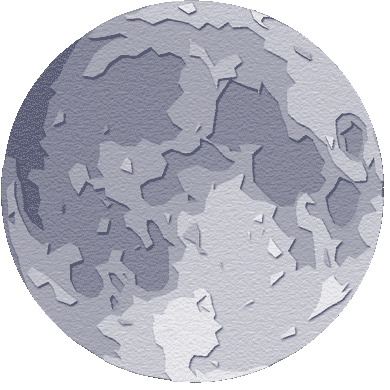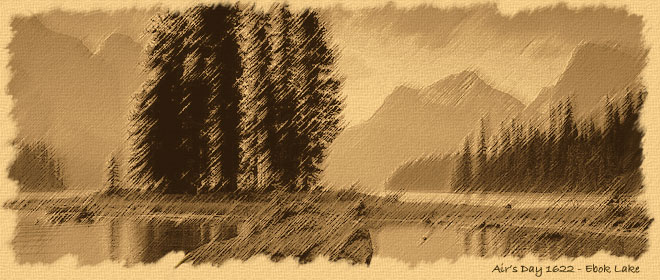The Barrowsash Calendar
The Barrowsash calendar is lunisolar—meaning that it uses both the lunar and solar cycles to denote the days of the year. It does so with a thirteen month system, the first twelve of which are based on the moon's phases.
Moon phase averaging
The lunar cycle repeats roughly every 29.53 days, so the first twelve months average this out by alternating between 29 and 30 days in length. This allows each lunar phase to fall on a date that remains consistent across each month. So if the full moon occurs on day 10 of the first month, it will also occur on roughly the 10th of every month of the current year. Because the lunar cycle is averaged, the hourly precision of the system is not exact, but close enough to date changing tides and nightly illumination.

The first 12 months of the year are subdivided into 10-day weeks that reset at the beginning of the next month. Because of this reset, the last day of every 5th week is skipped over. This naturally occurs at the end of months with 29 days. The "skip" allows each date of the month, and each moon phase, to be locked into a specific day of the week.
An important condition of moon phase averaging concerns the 30th day of 30-day months. None of the four key lunar phases are officially set to the 30th date, and are instead averaged to either the 29th or the 1st. This ensures consistency across months, and that no two "official" phases occur in a single month.
The 13th month
The 13th month, Lunamon, is a solar regulator. Its function is to resynchronize the calendar to the solar year and its changing seasons, as the Barrowsash calendar year begins on the Vernal Equinox or first day of Spring. This last adjustment month will also determine the dates of the following year's lunar phases.
Lunamon is an exception to the ten day week. Its week length is extended to match number of days in the month—11 commonly and 12 during leap years. These last two days have special day names. Leap years are handled in a familiar way, being those years divisible in whole numbers by 4, and century mark years divisible in whole numbers by 400.
This year's interactive calendar

The year is currently 1655 BE (Barrowsash Era), which is equivilent to March 21, 2022 to March 20, 2023 CE (Common Era) of the Gregorian calendar.
Below is this year's calendar. It provides a good look at the calendar's structure and typical Barrowsash events. Each date square contains the numeric date (top-left), the Gregorian calendar date equivelent (bottom-right), and the day of the year number (bottom-left). Moon phases and notable meteor showers (starbrushes) are represented on appropriate days. Major events are tinted green. Today's date box is white with a compass rose.
You can scroll through the months by using the scroll bar on the right side of the calendar or with a mouse's scroll wheel.
More information is provided below the calendar.

Calendar contained names
The Barrowsash calendar is mostly influenced by astronomical and earthly observation which is reflected in its day and month names. Days are named after planetary objects, in order out from the Sun, and consist of Soliday, Mercuday, Venday, Earthday, Marsday, Jupiday, Saturday, Uraday, Nepday, and Minorday. The last honors all of the minor planets, and is fittingly the day that is skipped at the end of 29 day months.
Day name history

Day names have seen several changes throughout the calendar's history, each reflecting changes in celestial science. At the time of the calendar's inception (367 CE), the Ptolemy model of the "planets" was used for the first 7 days—Moon, Mercury, Venus, Sun, Mars, Jupiter, and Saturn. The last three days were named for "bright stars" of the northern hemisphere—Sirius, Arcturus, and Capella. This earth-centric arrangement was changed in 1265 (1632 CE) in response to the publication of Dialogue Concerning the Two Chief World Systems by Galileo Galilei the prior year. This revision put things in the proper order, substituting Earth for Moon, and retained the three stars—Sun, Mercury, Venus, Earth, Mars, Jupiter, Saturn, Sirius, Arcturus, and Capella.
In 1443 (1810 CE), The Sun, Earth, and all three stars were dropped to make room for four newly discovered planets and the overdue Uranus—becoming: Mercury, Venus, Mars, Vesta, Juno, Ceres, Pallas, Jupiter, Saturn, and Uranus. By the time Neptune was discovered in 1479 (1846 CE), four of the planets had been reclassified as minor planets, causing another shuffle of day names. A rework of the names with the added "day" suffix also occurred at this time. In 1480 (1847 CE), the names were changed to: Solday, Mercuday, Venday, Earthday, Marsday, Jupiday, Saturday, Uraday, and Nepday, followed by a group name for the lesser planets of "Minorday."

The last two changes to the calendar's day names were both due to one little celestial body named Pluto. In 1563 (1930 CE), Minorday was changed to Pluday, and the week looked nice and tidy with the Sun and it's nine planets filling out the week. However, when Pluto fell out of planetary grace in 1639 (2006 CE) the calendar reverted back to its pre-Pluto state, with Minorday rounding out the week.
Day names have always been somewhat superfluous, as the numeric dates of the month are fixed to specific day names throughout the year. For example: the 4th of every month always falls on Earthday, as does the 14th and 24th. If it ends in "4" it's Earthday. Lunamon 11 and 12 are the only exceptions.
The last days of Lunamon
Special names are given to the last two days of the last month—Lunaday (11th) and Leapday (12th). Leapday only occurs periodically as its name implies. Together with the normal days of the week, each day of Lunamon bears a different date-specific name.
Month and moon names
Month and full moon names are more earthly by nature, but some also reflect a relationship with the sun and moon. Each month name is suffixed with "mon". Below is a list of the months with a short explanation for their names—and the name of its full moon.
Primon: The primary or first month of the year. It is home to the full Seed Moon.
Turnmon: The month of the turning or tilling of earth in preparation for planting. It is home to the full Hare Moon.
Finemon: The month of pleasant weather or usually at least, the first "fine" day. It is home to the full Milk Moon.
Faermon: The month of faeries, or more naturally, the month of fireflies. It is home to the full Firefly Moon.
Rosemon: The month of wild roses. It is home to the full Goose Moon.
Stormon: The month of heavy weather. It is home to the full Thunder Moon.
Reapmon: The month of the harvest. It is home to the full Salmon Moon.
Stockmon: The month of preparing and stocking food to last through Winter. It is home to the full Berry Moon.
Frostmon: The month of the first frost. It is home to the full Crystal Moon.
Yulemon: The month of the Sun's "rebirth", or the celebration of Yule. It is home to the full Long Moon.
Bittermon: The month marked by bitter cold. It is home to the full Blue Moon.
Oldmon: The month of the old moon, or last complete cycle before the new year. It is home to the full Strong Moon.
Lunamon: The month that celebrates the Moon. The "sometimes occuring" full moon of Lunamon is humorously known as the full Iffy Moon.
Business days
Most business is conducted seven days a week and honor the traditional days off, being Earthday (midweek) and Nepday/Minorday (weekend). Additionally, the fifteenth of each non-festival month is a considered a respite day, honoring an aspect of Barrowsash culture.
Barrowsash annual festivals, events and occasions
With the exception of full moons, nearly all community events occur on fixed annual dates. Dates for phases of the moon are fixed only within a specific year. It is important to note that Barrowsash is a secular society, fully in its government, and almost entirely in its population. Therefore, the calendar contains no "holidays" of any religious context.
There are four major annual festivals or "Heydays", each associated with the beginning of a climatic season.
Highfest: Containing the Summer Solstice.
Highfest celebrates the longest day of the year, which occurs in the middle of this 10-day festival. The festival spans the entire first week of Faermon, and is a well-deserved break after the long planting season. Highfest activities include sporting events, lively music and dancing, and the consumption of strawberries and cream.
Harvest Festival: The first week of Reapmon and includes the Autumnal Equinox.
This festival is all about food and drink, and the harvest isn't limited to land. You'll find fresh fish and game birds here, too. The bounty of the year's harvest provides ample fare for a variety of delectable dishes. Ciders, wines and spiced ales flow liberally throughout the ten day period. Prizes are awarded for the best of nearly everything the festival has to offer.
Yule: Twelve days in Yulemon, beginning the night before the Winter Solstice.
Yule is a celebration of the sun's rebirth, and is marked by hope, fellowship, good will, and an abundance of light. On the eve of the year's longest night, Barrowsash becomes awash in the light of bonfires, candles, and lamplight. Most of those original lights are kept lit throughout Yule and more are added each evening. The lights are said to bring joy to the sun and help it lift higher above the horizon with each passing day. Although gifts are exchanged throughout Yule, the fifth day of Yule is the traditional Gifting Day. On this day, folks present a special item from their winter food stock to a neighbor or friend. On the following night, each household uses this gift in the preparation of their Midyule meal. This tradition is said to reinforce the spirit of sharing and trust within the community. On Twelfth Night, the last evening of Yule, each child is presented with a new unlit candle. It is their charge to the keep it safe until next year's Yules Eve, when it will be used to ignite those Solstice lights.
Festival of the Moon: The entire month of Lunamon, immediately preceding the Vernal Equinox.
This festival celebrates the end of the old lunar cycle and preparation for the new. Because of the short month, the full moon doesn't always happen during Lunamon. So when the appropriately named Iffy Moon does occur, it's considered good luck. In general, the Festival of the Moon is a time for both work and play, as most folk are preparing for the upcoming growing season. Still it's a time to leave winter behind and have a bit of good-natured fun. Just before midnight on the last night of Lunary, New Year's Eve, chosen community leaders throughout Barrowsash announce the date of the new year's full moons. While the date is already common knowledge, it's a great excuse for a hearty toast.
The fifteenth of each non-festival month is set aside to celebrate an aspect of Barrowsash culture. There are nine such days.

Builder's Day: Primon
Planter's Day: Turnmon
Fisher's Day: Finemon
Founder's Day: Rosemon
Worker's Day: Stormon
Water's Day: Stockmon
Air's Day: Frostmon
Fire's Night: Bittermon
Fauna's Day: Oldmon
The Starbrushes:
Starbrushes are meteor showers that occur throughout the year. The estimated peaks of five major Starbrushes are noted on the calendar. These are fixed dates, although the actual peak dates and intensities may vary slightly from year to year.
Concept and all content ©1999-2022 Charlie Keller - Goodmany Arts